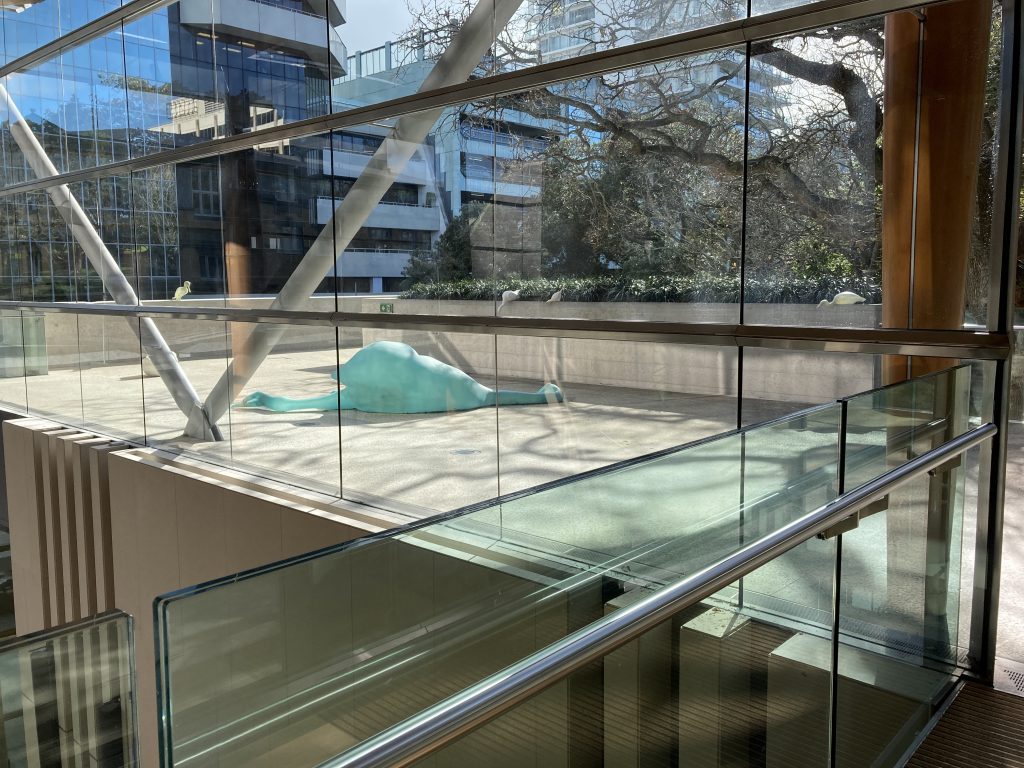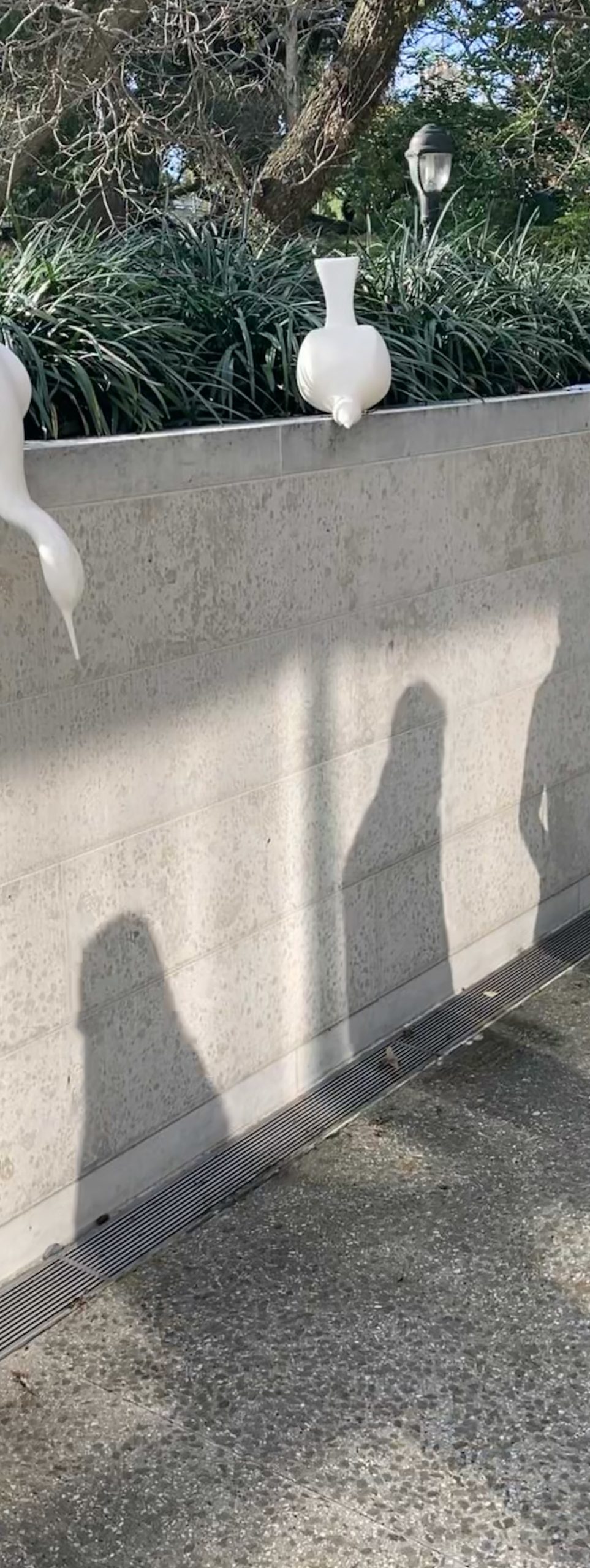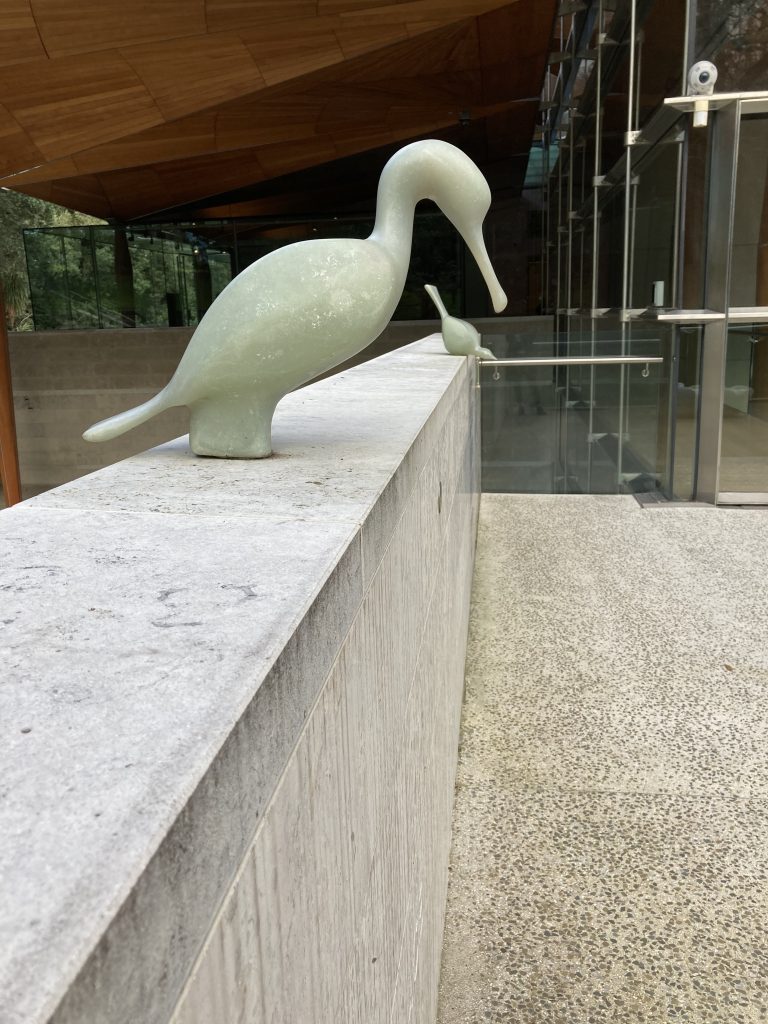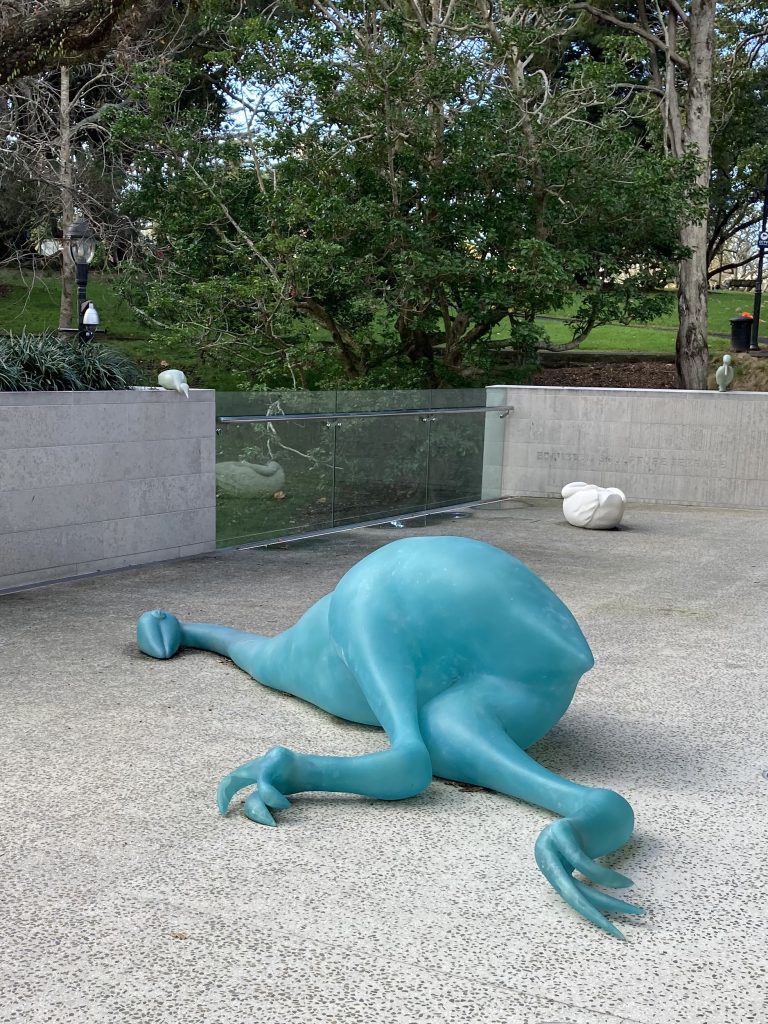The Interior
By Sorawit Songsataya
Auckland Art Gallery Toi o Tāmaki
Sat 23 Nov 2019 — Mon 23 Nov 2020
Moving across the open-air walkway from the heart of Auckland Art Gallery to the gallery’s North Sculpture Terrace, is like stepping into a land before time. Natural light bounces off the windows flooding the crossing with warmth and luminosity. The huge glass sensor door acts as a guardian to the space, welcoming every footfall without discernment, to enter The Interior; a commissioned installation by Thai born, Wellington-based artist Sorawit Songsataya.

To the left of centre of this outdoor rectangular gallery space, glowing in its own uranium blue radiance, is the artist’s impression of a seemingly life-size moa — it lies motionless on the exposed concrete floor. The form’s large fibreglass body holds an intensity in colour, volume and awe comparable to a glimpse of the majestic Huka Falls from a tourist lookout post. Moving around the sculpture, which sits at roughly twice my body length, my own human-sized shadow expands and contracts across the creature’s protruding belly, and this manifests feelings of guilt and grief in the wake of human-led intervention causing extinction. Moving in close, there are shaped claws at the end of long blue toes and these are large and sharp, reminiscent of the replica’s once mighty living counterpart, capable of clutching and clenching. This opportunity to be before New Zealand’s largest flightless bird, in the flesh or fibreglass is a privilege, its blue bulging eye offering a glimpse into a previous existence — a cool reminder of life and death, of prey and predators.
The sound of birds from neighbouring Albert Park bring a playful vibe to the scene, and this draws my attention upwards, from the imagined forest floor to the gallery’s half-walled perimeter. Moulded in the likeness of both native and endemic New Zealand bird species, perch life-size sculptures. Some are hand-carved from Oamaru stone, others have been made using digital modelling and casting techniques. Some have outstretched necks and probing beaks while others appear stately and disinterested. Cool to the touch, they are robust and unassuming in their minimal forms, their neutral tones in strong contrast to the stark enigma of the blue moa below.
I encounter this installation in a similar way to my practice of making, from a bodily, sensorial perspective: to see, to smell, to touch, to hear — the vital hum of the forest, the screeches and whoops between the birds of Aotearoa, past and present. I enjoy the physicality of striding alongside the outstretched moa, craning my neck with the curious kereru, moving between the assembled pieces, in an attempt to make sense. This kinaesthetic experience invites me to step in time with those that have walked before me, and those that will follow: I am the mighty moa – fallen and exposed, I am the poūwa – with my head buried in my chest, I am the roots that reach from the neighbouring trees that push up, from beneath the concrete floor. There are invisible energies in action, what political theorist Jane Bennett might describe as vital materiality, “where everything is alive, interconnected, and in process” [1].
The Interior evokes an ecological sensibility; one that is both inward and outward looking; one that feels the natural world more intensely in the moment; one that calls for unification, to identify the self with the larger collective of all living things. Reading the gallery’s publication, Life in the interior by Robyn Maree Pickens, available onsite, I warm to the writer’s call for “interspecies attentiveness and attunement” [2], stimulated by The Interior. To be present in the company of these artefacts, means to become part of an unfolding conversation that dips into political, historical and ecological dimensions; that integrate past, present and future happenings; where human and non-human species strive for more sustainable relationships, as a way to make it in this so-called troubled world [3]. I think about Te Tiriti o Waitangi’s principle of protection, and the taonga of Aotearoa. I feel the weight of the natural treasures that are no longer alive or are struggling to live, and this is mirrored in the material weight of the bird-like sculptures that I stand alongside.
The arrangement of these sculptural objects is not accidental. Songsataya used the painting Te Tangi o Te Moa’ (1907), by Trevor Lloyd, held in the Gallery’s collection [4], as a resource for positioning the birds in The Interior, but unlike the painting; busy with flora, fauna and impressions of avian and mythical lifeforms, Songsataya declutters the composition, making the layout more spacious and human body-friendly via the installation of birds as objects in the outdoor gallery. The artist uses the half-wall of the stadium-like arena to situate the majority of avian sculptures, and this invites a sense of community amongst human and non-human species especially when the gallery is; bustling with people, and audibly active in relationship with the surrounding natural environment. The large moa centre-piece offers a grounding presence, although ironically it is the most mystical and alien-looking piece in the space. I tap on its shell-like surface and yearn to revive the body with warmth and attention, but it remains blue with cold.
Songsataya’s fascination with materiality and what it means to be a maker in a contemporary art context is also evident: the plethora of possibilities and perspectives; material, method and presentation choices; environmental conditions to consider and make use of. The Interior’s co-habitation of sculptural pieces made from: fibreglass, polyester resin, acrylic lacquer, and Oamaru stone, invite one to deliberate and fascinate in the artist’s intermingling of materiality and approaches to making. The juxtaposition of hand-made and machine-made pieces is significant, apart from the visual diversity this provides, an appreciation for the contribution of craft skills that may be either extinct or critically endangered, are posited alongside equally valued technology-driven methods that lend to accuracy and efficiency.
There is sadness in knowing that The Interior has an expiry date, and I wonder where these material pieces will dwell once this year long installation comes to end. Honouring the magical and hopeful essence of this work, I envisage the blue moa wondrously waking just before midnight, ambling over the gallery’s half-wall, to take a stroll through Albert Park — looking for a new way home. I’ll keep an eye out for a footprint.
- Montgomery, Nick. “Summary: Vibrant Matter by Jane Bennett” Cultivating Alternatives. Para 3, https://cultivatingalternatives.com/2013/11/28/summary-vibrant-matter-by-jane-bennett/ (accessed 12 August, 2020).
- Pickens, Robyn Maree. Life in the interior. Auckland Art Gallery Toi o Tamaki Publication, for Sorawit Songsataya, The Interior (2019), para 2.
- Haraway, Donna. Staying With The Trouble, Durham: Duke University Press, 2016, p. 76.
- Lloyd, Trevor. Te Tangi o Te Moa, watercolour, (1907). Auckland Art Gallery Toi o Tāmaki, bequest of Miss Connie Lloyd, 1983. https://www.aucklandartgallery.com/explore-art-and-ideas/artwork/5907/te-tangi-o-te-moa


